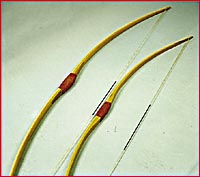![]()
Archery
, art, practice, or skill of using a bow and arrow for hunting, warfare, or as a sport.| The traditional Longbow | The "Olympic Recurve" bow | The Compound Bow |
 |  |  |
| The traditional long bow has changed little in hundreds of years. Traditionally made of Yew, but often made from a variety of woods. | The Olympic Recurve is so called as it is the only type of bow that is used in olympic competition. Note how the limbs curve in an S shape. These bows are usually made of wood with fibreglass laminations, or carbon fibre and are either a solid "one piece" bow or have a seperate wooden or metal handle section (called the "riser") that the limbs bolt onto. | Notice how, unlike the other two bows, the compound bow has a string (or cable)which travels around a number of pulleys or "cams". These cams are offset or "eccentric" and give a mechanical advantage that has the effect of reducing the amount of effort needed to pull the string back as the string is pulled back. The first few inches of pull may require 60 pounds of pull, but this weight falls away, to a fraction of the weight by the time the archer reaches full draw |
 |
 |
Many traditional family surnames come from the world of archery.
Archer being the obvious one, but also "Bowman", "Bowyer" (a maker of bows), "Arrowsmith" and "Fletcher" (both makers of arrows)
History
Some authorities date the origin of archery as early as the Aurignacian period, about 25,000 years before the modern era. The earliest people known to have used the bow and arrow were the ancient Egyptians, who adopted the weapon at least 5,000 years ago. In the time of the earliest pharaohs, the Egyptians practised archery in hunting, as well as in warfare against the ancient Persians, who were then equipped only with spears and slingshots. Soon afterwards, however, the bow and arrow was used extensively in the ancient world. During the Middle Ages the most notable European archers were the English, whose longbows proved decisive at the battles of Crecy (1346) and Agincourt (1415).
Archery also played a role in the folklore of the Middle Ages. According to legend, 14th-century Swiss marksman William Tell was ordered by an Austrian governor to shoot an apple off his own son's head with a bow and arrow. In addition, the story of Robin Hood, the heroic outlaw, originated in the late 14th or early 15th century. Robin Hood, glorified for stealing from the rich and giving to the poor, wielded a bow and arrow. He was famous for his accurate marksmanship, including the ability to split one arrow with another.
Archery as a Sport
Archery has long been popular as an amateur sport, particularly in England. The oldest continuously held archery tournament still extant, known as the Ancient Scorton Arrow, was founded in Yorkshire in 1673; and in 1781 the Royal Toxophilite (Greek, toxon, "bow"; philos, "loving") Society was formed to advance the sport. The Grand National Archery Society, the official organization of British archery, was established in 1844, and it has conducted championship contests since that year.
Ascham, Roger (1515-1568), English scholar and author, a major intellectual figure in Tudor England. Ascham was born in Kirby Wiske, Yorkshire. Ascham published a popular treatise on archery called Toxophilus in 1545. This work, which was a defence of physical recreation for scholars, was dedicated to King Henry VIII of England. The essay pleased the king, who granted the author an annual pension. Ascham was appointed tutor to Princess Elizabeth, later Queen Elizabeth I, in 1548. His instruction was at least partially responsible for her proficiency in Latin and Greek and her lifelong love of the Classics.
Archery was held in the Olympic Games of 1900, 1904, 1908, and 1920. It was then discontinued until it again became an Olympic sport for men and women at the 1972 Munich Olympic Games. Modernized in 1992 to promote interest, the Olympic round consists of a ranking round, an elimination round, a finals round, a team elimination round, and a team finals round. The individuals' event includes 64 archers, all shooting at the same time at targets 70 m (230 ft) away. Archers with the highest scores after various elimination heats compete for medals. The competition is conducted according to the International Archery Federation's rules.